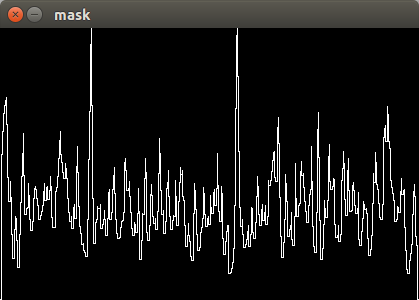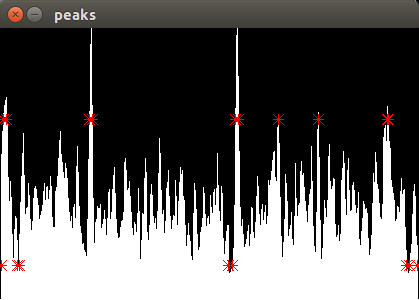Find all peaks for Mat() in OpenCV C++
I want to find all peaks for my image. I need it to divide my picture such way:

So, i already asked question, how to project all image to one of the axis, and now i need to find all maximums on this one-row image. Here's my part of the code:
void segment_plate (Mat input_image) {
double minVal;
double maxVal;
Point minLoc;
Point maxLoc;
Mat work_image = input_image;
Mat output;
//binarize image
adaptiveThreshold(work_image,work_image, 255, ADAPTIVE_THRESH_MEAN_C, THRESH_BINARY, 15, 10);
//project it to one axis
reduce(work_image,output,0,CV_REDUCE_SUM,CV_32S);
//find minimum and maximum falue for ALL image
minMaxLoc(output, &minVal,&maxVal,&minLoc,&maxLoc);
cout << "min val : " << minVal << endl;
cout << "max val: " << maxVal << endl;
As you can see, i could find one maximum and one minimum for all picture, but i need to find local maximums. Thanks for any help!
EDIT Ok, so i made a mistake, i need to find peaks for this vector. I've used this code to find first peak:
int findPeakUtil(Mat arr, int low, int high, int n) {
// Find index of middle element
int mid = low + (high - low)/2; /* (low + high)/2 */
// Compare middle element with its neighbours (if neighbours exist)
if ((mid == 0 || arr.at<int>(0,mid-1) <= arr.at<int>(0,mid)) &&
(mid == n-1 || arr.at<int>(0,mid+1) <= arr.at<int>(0,mid)))
return mid;
// If middle element is not peak and its left neighbor is greater than it
// then left half must have a peak element
else if (mid > 0 && arr.at<int>(0,mid-1) > arr.at<int>(0,mid))
return findPeakUtil(arr, low, (mid - 1), n);
// If middle element is not peak and its right neighbor is greater than it
// then right half must have a peak element
else return findPeakUtil(arr, (mid + 1), high, n);
}
// A wrapper over recursive function findPeakUtil()
int findPeak(Mat arr, int n) {
return findPeakUtil(arr, 0, n-1, n);
}
So now my code looks like:
void segment_plate (Mat input_image) {
Mat work_image = input_image;
Mat output;
//binarize image
adaptiveThreshold(work_image,work_image, 255, ADAPTIVE_THRESH_MEAN_C, THRESH_BINARY, 15, 10);
//project it to one axis
reduce(work_image,output,0,CV_REDUCE_SUM,CV_32S);
int n = output.cols;
printf("Index of a peak point is %d", findPeak(output, n));
But how can i find another peaks? The algorithm of peak finding i took from here.





